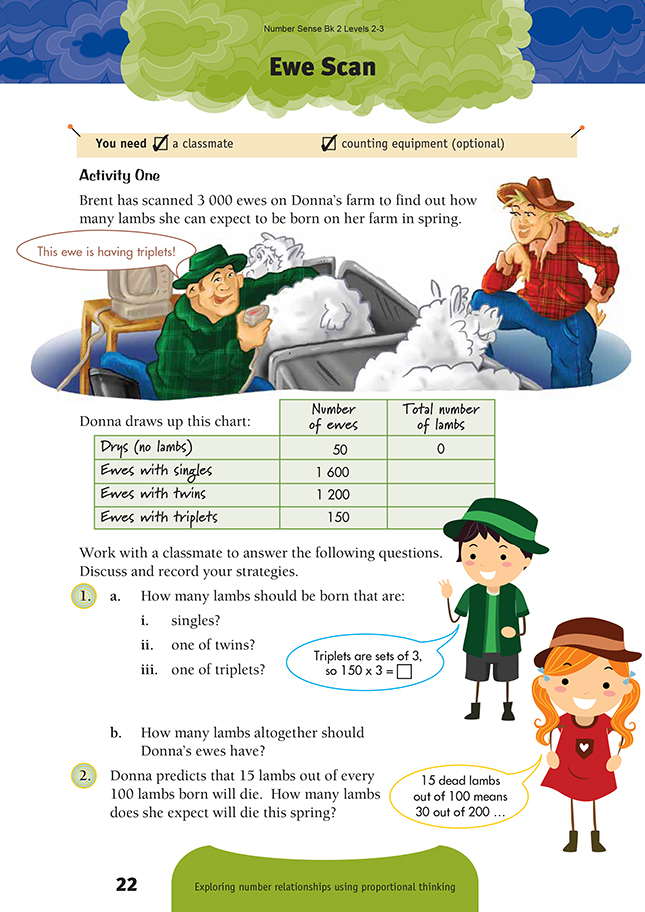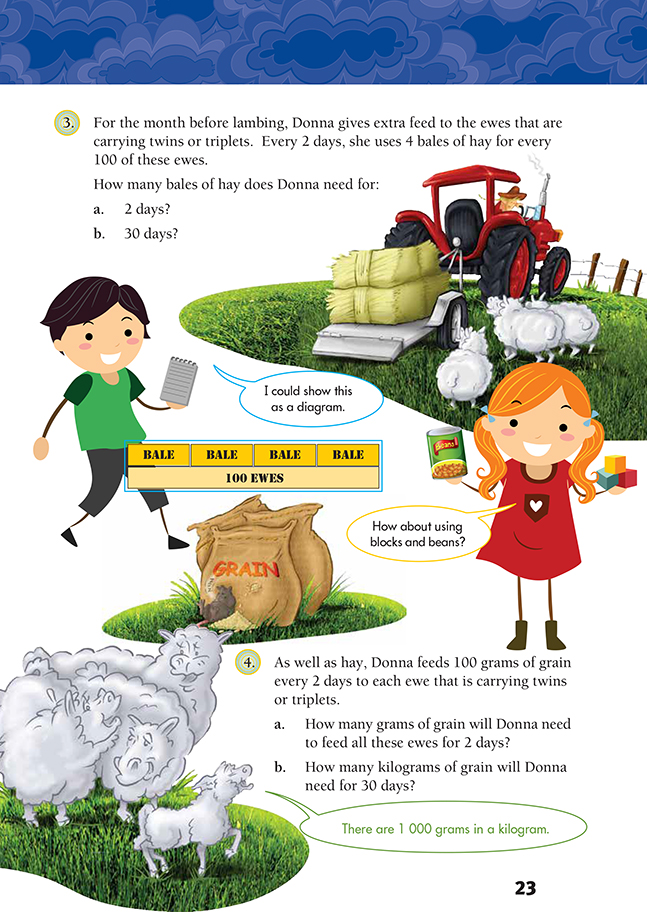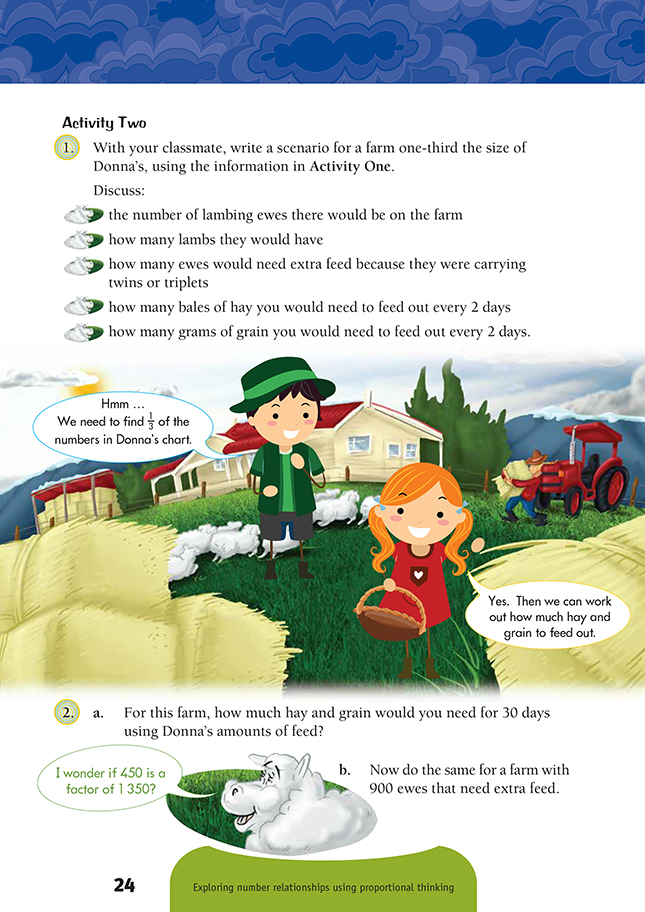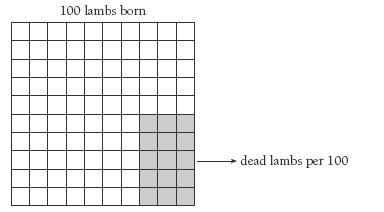This is a level 4 number activity from the Figure It Out series. It relates to Stage 7 of the Number Framework.
Click on the image to enlarge it. Click again to close. Download PDF (161 KB)
solve problems using simple proportions
Number Framework Links
Use these activities to:
• help the students who are beginning to use advanced additive strategies (stage 6) to become confident at this stage in the domains of multiplication and division and proportions and ratios
• encourage transition from advanced additive strategies (stage 6) to advanced multiplicative strategies (stage 7) in the domains of multiplication and division and proportions and ratios
A classmate
FIO, Levels 2-3, Number Sense and Algebraic Thinking, Book Two, Ewe Scan, pages 22-24
Counting equipment
Activity One
The connections between the various quantities of ewes, lambs, and feed used in this context allow a variety of strategies to be applied to the problems. During the reporting back time, encourage the students to think of some simple proportional strategies. These strategies involve finding a multiplicative relationship between two or more different quantities.
The students may need to revise the number of grams in a kilogram as well as multiplying and dividing by 10, 100, and 1 000. You could use series of mental questions such as:
• 3 000 grams = kg
• 5 x 100 =
• 10 x 100 =
• 15 x 100 =
• 6 kilograms = grams
• 5 000 ÷ 100 =
• 5 000 ÷ 10 =
• 5 000 ÷ 1 000 =
• 45 000 ÷ 1 000 = .
Introduce the context and ensure that the students understand the chart showing drys, singles, twins, and triplets. Have the students move into small groups to attempt question 1.
Materials may be useful for question 2. After the students have found the total number of expected lambs in question 1b, help them to understand question 2 by showing them how to use place value blocks, multilink cubes, bead frames, or similar materials to represent the groups of 100 lambs and use counters or 1 centimetre cubes to show the dead lambs.
Help the students to use number properties by modelling a ratio table to record the results shown by the materials:
Focus on the column showing 100 lambs. Challenge the students to find the connections between that column and all the others up to 4 000. If they describe addition or subtraction connections, ask them to try duplicating the 100 lambs with materials to see what works instead. Good scaffolding questions are:
300 is 3 x 100, so there will be 3 x 15 dead lambs.
Use a connection to work out the lambs lost in the 400 column.
What connection can we use between the 400 column and the 4 000 column?
How can you use what you have found out to work out the 4 450 column?
Question 3 can be approached in the same way with 4 bales of hay for every 100 ewes:
Again, discuss the strategies used to complete the table with a focus on multiplicative connections, for example: 500 is 5 x 100, so there will be 5 x 4 = 20 bales.
Make the most of question 4 as a measurement task by having the students find or describe objects that may weigh 100 grams and checking them on a balance or kitchen scale (for example, a small potato, a bag of peanuts, or a medium-sized chocolate bar). Another ratio table will help the students to see connections that can help the calculation strategies:
Activity Two
In the students’ scenario, they use Donna’s farm numbers as the guide for their farm. So in question 1, they need to find one-third of the numbers of sheep that Donna has in each category and use this as the basis for working out the extra feed for 2 days.
Before the students attempt question 2a, have them respond to the sheep’s query in the speech bubble and encourage them to see the link to Donna’s chart: How can you use the fact that 450 x 3 = 1 350 to help you answer the question?
An alternative strategy would be to use the appropriate columns in the ratio tables used for Donna’s farm to make up the 450 ewes and match up the hay and grain.
If students do not see the connection between questions 2b and 2a, say: Compare the number of ewes in questions 2a and 2b. What do you notice?
Answers to Activities
Activity One
1. a. i. 1 600
ii. 2 400. (1 200 x 2)
iii. 450. (150 x 3)
b. 4 450. 1 600 + 2 400 (twins) + 450 (triplets) = 4 450 lambs
Strategies for question 1 will vary. First, you need to double or treble, by addition or
multiplication, to find each individual amount. You might look for compatible numbers (for example, 600 + 400) when adding up all the lambs.
2. 668 lambs (rounded). Strategies will vary. For example, 4 450 lambs is 44.5 lots of 100 lambs. 10 x 44.5 = 445. 5 x 44.5 or half of 445 is 222.5. 445 + 222.5 = 667.5. You can’t have half a dead lamb, so you need to round your answer.
3. a. 54 bales. Strategies will vary. One way is to see 1 350 (the number of ewes involved) as 13 hundreds and a hundred. So that’s 13 x 4 bales + 2 bales (for the extra 50 sheep), which is 52 + 2 = 54.
b. 810 bales. 30 ÷ 2 = 15 lots of 2 days (as in question 3a). 54 x 15 can be seen as
54 x 10 = 540 and 54 x 5 (or 540 ÷ 2) = 270. 540 + 270 = 810.
4. a. 135 000 g. (1 350 x 100)
b. 2 025 kg. (135 000 g x 15 can be seen as 135 000 x 10 = 1 350 000 and 135 000 x 5 [or 1 350 000 ÷ 2] = 675 000. 1 350 000 + 675 000 = 2 025 000.
2 025 000 g ÷ 1 000 = 2 025 kg.)
Activity Two
1. Descriptions may vary, but the following information needs to be included:
• 984 lambing ewes (534 [rounded] + 400 + 50)
• 1 484 lambs (534 + 800 + 150)
• 450 ewes that need extra feed
• 18 bales of hay every 2 days ( of Activity One, question 3a’s answer)
• 45 000 g of grain ( of Activity One, question 4a’s answer) every 2 days
2. a. 270 bales of hay and 675 kg of grain. (450 x 3 = 1 350, so 810 ÷ 3 = 270 and
2 025 ÷ 3 = 675)
b. 540 bales of hay and 1 350 kg of grain. (2 x 450 = 900, so 2 x 270 = 540 and
2 x 675 = 1 350)





